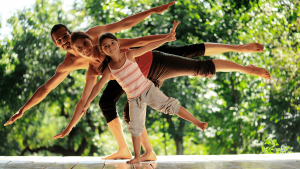Calming your Nervous System
When I was training to be a midwife, a health visitor, a yoga teacher and a reflexologist, one topic kept coming up over and over again: the nervous system. I used to think my nerves just told my arm to move, or whether my tea was too hot to drink. Now I know the nervous system regulates all the different processes of the mind and body. My thoughts, emotions and body are not separate entities, but intimately interconnected. While some stress is good for us, excessive and uncontrolled stress is toxic. This is why we absolutely need calm on a daily basis.
Keeping it simple
Whole books have been written on the complex effects of stress on the body and mind. I only have space here for a brief overview. I promise to keep it simple. But I do think this is important, because understanding a bit about calm and the nervous system can help motivate you to develop regular calm practices. Meditation, breathing practices and all the rest aren’t just woo. We know from science that they have real and measurable effects on our mental and physical wellbeing. As someone with a scientific background, I really like this.
Autonomic nervous system
Your nervous system is the super-complicated way your body coordinates basically everything that goes on inside you. The somatic nervous system which is the one you use when you decide to move your arm to pick up that cup of tea. It controls voluntary movements. The autonomic nervous system isn’t under your direct conscious control. It basically tells your organs and internal processes what to do from moment to moment to keep you alive.
You also have an enteric nervous system, which controls your gastrointestinal system. This may be involved when we talk about having a gut feeling about something. The key point about the autonomic and enteric nervous systems is that you can’t control them directly, but they are crucial in determining how you feel and function. However, the good news is that there are lots of ways you can influence them indirectly, and feel better as a result.
Sympathetic and Parasympathetic
So let’s zoom in on the autonomic nervous system – the one that controls all your organs. This system dates all the way back to our reptilian ancestors. The autonomic system is controlled by your hypothalamus in your brain and by hormones or neurotransmitters. It has two main branches, called the sympathetic nervous system and the parasympathetic nervous system. This is where calm comes in.
The sympathetic nervous system is in charge of the “fight or flight” response. When your body senses danger, challenge or threat, the sympathetic nervous system takes charge. Stimulated by hormones like adrenaline or norepinephrine, it tells your heart to beat faster, your blood to clot more readily, your brain to be on full alert, your liver to metabolise glucose and your skin to sweat. It is getting you into the best possible state to survive an attack. If a wild animal gores you, you will bleed less. If you have a chance to run away, you will run faster. You will think quickly and hopefully find a way to survive.
That is super helpful in dangerous or challenging situations. And it is important to remember that stress is good for us, in limited amounts. But lets look at the other branch of the autonomic nervous system, the parasympathetic nervous system. This is the one that is in control when we feel calm. Activities like yoga, meditation, massage and spending time in nature all help wake up the parasympathetic system. It is often called the “rest and digest” response. In this state your breathing and heart rate slows. Your blood pressure is lowered. Your digestive system gets to work, and the creative right hemisphere of your brain takes charge. You feel calm and maybe a bit sleepy. Your body gets the opportunity to repair damage to cells and organs. A sense of connection and warmth predisposes you towards positive and loving relationships with others. The body and the emotions are in a healing state of rest.
The Vagus Nerve
You might have heard people talk about the vagus nerve. It contains eighty per cent of all the parasympathetic nerve fibres in the body, so it’s important when we want to get into that lovely relaxed state. The vagus nerve has two branches, and it runs from the brainstem down through the neck and chest to the gut. It influences your heart rate and digestion, as well as your immune system. There is more and more evidence that activating the vagus nerve can help with all sorts of major health problems such as post-traumatic stress disorder and inflammatory bowel disease. https://www.ncbi.nlm.nih.gov/pmc/articles/PMC5859128/
One of the ways to help the vagus nerve get you into a relaxed state is through gentle pressure around the eye sockets. That is why children (and adults) instinctively rub their eyes when they are getting ready for sleep.
Balance is key
Our wellbeing depends on getting the right balance between the sympathetic and parasympathetic states. If we are always calm and sleepy, we may become bored, sluggish and depressed. On the other hand, excessive excitement and over stimulation without opportunities for rest and recovery will make us ill and eventually kill us. The effects of stress are cumulative. Unrelieved stress weakens the immune system, making us more likely to catch infectious diseases. It also makes us more prone to heart disease, stomach ulcers, cancers and serious mental health problems. Stress without rest is seriously bad news.
The good news
We all have stress in our lives, but the good news is that there are lots of ways we can learn to get into that restful parasympathetic state. One of our superpowers as humans is our ability consciously to control our breathing. Animals generally can’t do that. Slowing down your breath using breath work exercises is one simple way to get your nervous system into a relaxed mode. The ancient Yogis of India discovered that and amazed people by entering almost living-death-like states through long practice. I’m not suggesting that you try and stop your heart (!), but you can easily learn to slow it down to help yourself feel calm.
Calm practices
The calm practices that I will be suggesting in this series are designed to help you enter the parasympathetic “rest and digest” state. By deliberately introducing simple calming activities into your daily life, you can help balance your nervous system, improve the health and function of your body, and feel better.
Today’s Calm Practice – Rest with an Eye Pillow
Gentle pressure on the eye sockets activates the vagus nerve and helps you get into a relaxed, parasympathetic state. Today, find ten minutes when you can lie down undisturbed in a quiet place. If you have an eye pillow – a small cushion filled with rice or something similar – settle this over your eyes. If you don’t have an eye pillow, try using a small folded towel over your eyes, or alternatively lie facing downwards with a cushion under your forehead. You might also like to give yourself a gentle massage around the outside of your eyes with clean fingertips.
Put some relaxing music on, if you like. Just rest quietly. Set a timer for ten minutes, or stay longer if you have time. Notice how you feel afterwards. The eye pillow should help slow your breathing and heart rate so you feel calm and relaxed.
If you can, please share how you got on in the Nurture Yourself Group on Facebook. This is encouraging for us all. Thank you.
Thanks for reading this blog post. I am writing a series of 31 blogs every day this August. I plan to publish them later in the year as a book entitled, ‘Finding Your Calm Space – 31 Ways to Find Calm in a Crazy World’.
Click here to download a video of me talking you through a simple body scan relaxation.
I’m Karen. I am a Yoga teacher, Reflexologist and busy mum of seven. I live with my family in Billericay, Essex, UK. In the past I have worked as a Midwife, Health Visitor, Baby Signing teacher and Tax Inspector. I love getting outdoors, swimming in the sea, walking and writing. Helping people relax is one of the things I do best.
You can learn more about my Yoga classes and Reflexology at my website www.thecalmspace.co.uk
Links for further reading:
If you are interested in the science of relaxation, here are a couple of bits of further reading.
Description of the nervous system:
https://en.wikipedia.org/wiki/Nervous_system
Functions of the Vagus Nerve:
https://www.ncbi.nlm.nih.gov/pmc/articles/PMC5859128/
For Yoga teachers and therapists, my favourite book about all this and much more is called “A Physiological Handbook for Teachers of Yogasana”, by Mel Robin. It is long, but fascinating!




Like!! Really appreciate you sharing this blog post.Really thank you! Keep writing.
Thank you ever so for you article post.
I really like and appreciate your blog post.
I love looking through a post that can make people think. Also, many thanks for permitting me to comment!
So glad you found it interesting